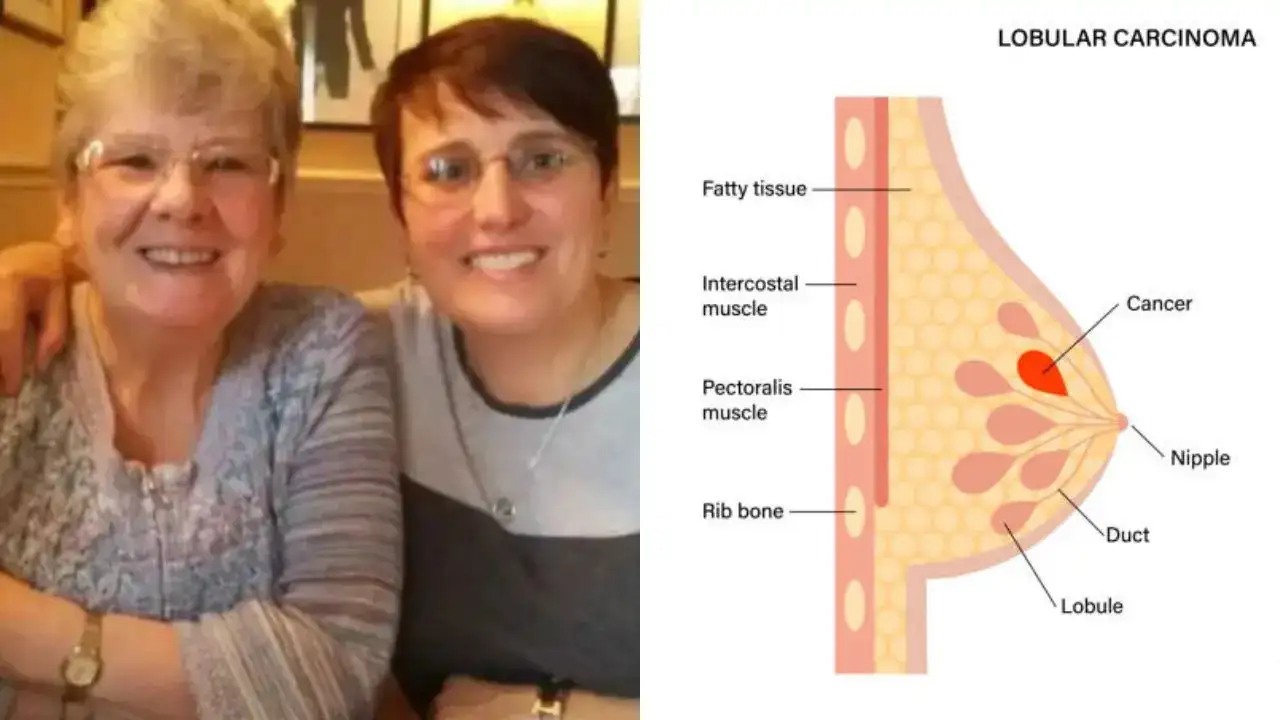
Sue first spotted changes in her breast which included redness and inflammation while still caring for her mother in her last days
A young woman, planning her mother’s funeral, who died of breast cancer, was diagnosed with the same disease within a week. Just five days after her mother Betty died, 59-year-old Sue from Bedfordshire was diagnosed with inflammatory breast cancer after she noticed red spots.
She first spotted the change while still caring for her mother in her last days. Sue said as she looked in the mirror every day, she could notice redness becoming deeper, with swelling and her breast feeling heavy. However, cancer was the last thing she thought she would have.
“I wasn’t worried,” Sue says. “I thought I’d knocked it against something while moving mum around the house. “I showed my wife Linda, and she agreed it was a different size. But because I knew I only had a few weeks left with Mum, she was my priority, and I pushed my thoughts aside to focus on our time together.” Sue’s doctor told her she had mastitis—the inflammation of the breast tissue that occurs with or without infection. It is most common in breastfeeding women but can also affect non-breastfeeding women as well as men. “I was prescribed antibiotics and given an urgent referral to a breast screening clinic.”
After getting over her mother’s last rights, Sue got all her tests done and was told she had rare and aggressive inflammatory breast cancer, in which the cancer cells block lymph vessels in the breast skin, causing the breast to appear red, swollen, and inflamed, often resembling a rash or infection. According to statistics, this type of cancer accounts for less than five per cent of breast cancers and tends to develop quicker than other more common types of the illness.
“The shock was overwhelming,” she says. “I was in stage 3B because it had been caught so late. And the fact mom had just died of breast cancer made it so surreal, like an out-of-body experience.
Was Sue’s cancer genetic?
According to Sue, her cancer was not genetic, as she was told that it was not the same type as her mother had. “A breast cancer nurse assured me it wasn’t genetic and wasn’t exactly the same type of breast cancer mom had,” she said.
Sue’s mother had metastatic cancer, which began with a melon-sized lump under her armpit, which she had initially kept a secret. “When it spread to her womb, she had a hysterectomy, and then the disease eventually spread to her spine and liver. I had all the symptoms of IBC—dimpled orange peel-like skin, heaviness, pain, and the redness that I’d first noticed.”
Sue is now receiving ENHERTU - a type of chemotherapy known as a breakthrough in breast cancer treatment - providing patients with more time every three weeks for her stage 4 cancer.
What is inflammatory breast cancer?
Inflammatory breast cancer appears as a rash, creating skin texture on the affected breast similar to an orange peel. IBC causes pain, redness, swelling, and dimpling on the affected breast. IBC results when cancer cells block lymph vessels — the small, hollow tubes that allow lymph fluid to drain out of your breast. The blockage leads to inflammation, leading to symptoms that make it easy to mistake IBC for an infection.
According to doctors, IBC grows fast and requires immediate treatment.
Who is high at risk for IBC?
Doctors say while anyone can develop inflammatory breast cancer, certain factors that may raise your risk include:
Sex
IBC can affect anyone, but it is more common in women
Age
Inflammatory breast cancer is most commonly diagnosed in women who are younger than 40 years of age. The median age of diagnosis is 57 years.
Race
Black women are more likely to get diagnosed with IBC
Weight
Women who are obese or overweight are more likely to get diagnosed with IBC.
Signs and symptoms of IBC
Symptoms of IBC progress quickly, over three to six weeks, and may include:
- Areas of discolouration: red, pink, or purple - a bruise or rash spread over one-third of your breast
- Dimpling, pitting, or thickening of your breast skin that resembles an orange peel
- Pain, swelling, itchiness, firmness, or tenderness in one breast
- Warmth, burning, heaviness, or enlargement of one breast
- Inverted or retracted nipple
- Swollen lymph nodes near your collarbone or under your arm
Get Latest News Live on Times Now along with Breaking News and Top Headlines from Health and around the world.


